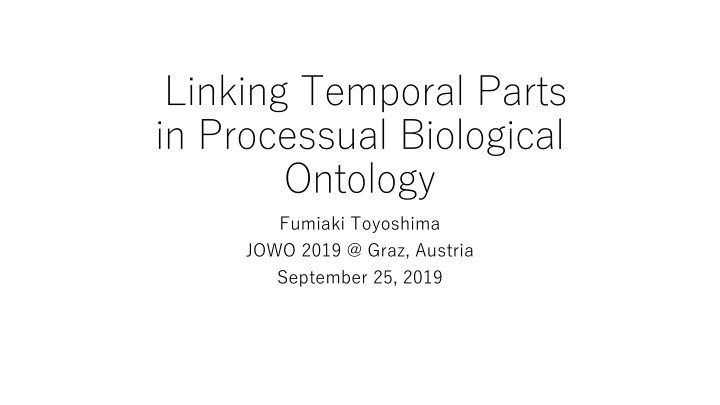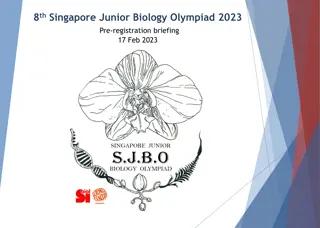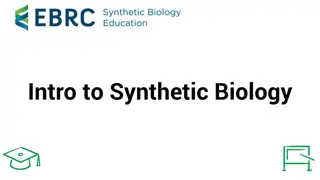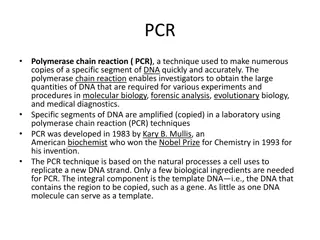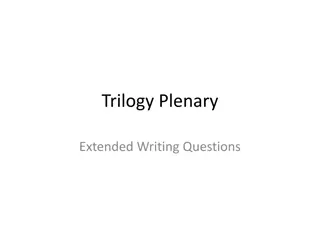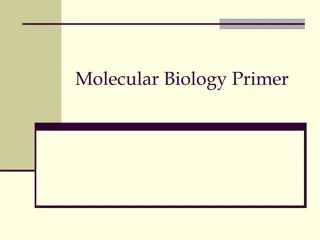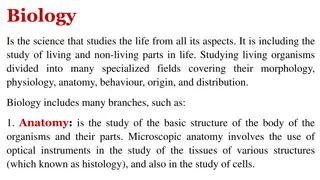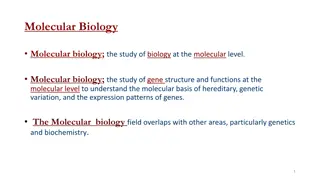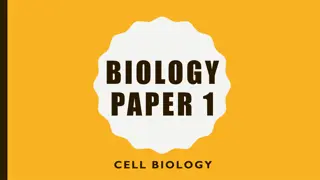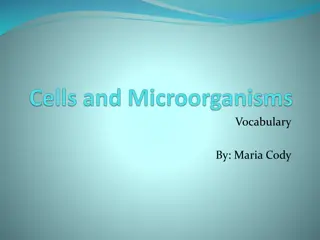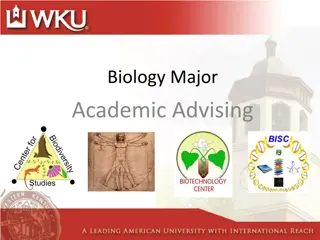Harmonizing Substantialism and Processualism in Biology
Biological ontologies often adopt either substantialism or processualism, leading to challenges in unification. This study aims to find a practical strategy to harmonize these differing views, enhancing interoperability in biology.
Download Presentation

Please find below an Image/Link to download the presentation.
The content on the website is provided AS IS for your information and personal use only. It may not be sold, licensed, or shared on other websites without obtaining consent from the author.If you encounter any issues during the download, it is possible that the publisher has removed the file from their server.
You are allowed to download the files provided on this website for personal or commercial use, subject to the condition that they are used lawfully. All files are the property of their respective owners.
The content on the website is provided AS IS for your information and personal use only. It may not be sold, licensed, or shared on other websites without obtaining consent from the author.
E N D
Presentation Transcript
Linking Temporal Parts in Processual Biological Ontology Fumiaki Toyoshima JOWO 2019 @ Graz, Austria September 25, 2019
Background Topic: objects and processes vis- -vis the biological domain E.g., molecules, cells, organs, organisms E.g., cell division, heart pumping, an organism s progressive development. Two major views of objects/processes Substantialism: Objects are more fundamental than processes. Processes are, in some sense, activities of objects. Processualism: Processes are more basic than objects Objects are, in some sense, abstractions of processes. 2
Motivation and goal Some biological ontologies adopt substantialism but others processualism. Difficult to unify those foundationally different ontologies Goal: To look for a practical strategy for harmonizing the substantialist and processual views of biology This will contribute to the long-term enhancement of the interoperability of different biological ontologies 3
Substantialism and processualism in biology The traditional substantialist s worldview in biology Processes always involve the doings of objects They merely reflect the change in the properties of objects over time E.g., the process of mitosis cell division as a sequence of the activities (e.g., DNA replication) of cells An increasing interest in processualism in biology E.g., an organism as fluid processes of matter and energy that exhibit dynamic time-relative stabilities E.g., most biological objects (e.g., organisms) as a series of morphological and behavioral changes during their life cycles 4
Ontology of persistence: Endurantism vs. perdurantism An object persists if and only if it exists at one time, and also exists at another distinct time E.g., a frog persists: It existed as an embryo and exists as a tadpole. Perdurantism: Objects persist by perduring , i.e., by having (proper) temporal parts (TP) E.g., a frog has its embryo TPs and its tadpole TPs Endurantism: An object persists by enduring : it is wholly present (standardly: do not have (proper) TPs) at every time at which it exists. 5
Linking substantialism/processualism with endurantism/perdurantism Perdurantism fits well with processualism General recognition: Processes are temporally extended and they have temporal parts. Perdurantism recognizes the primacy of processes over objects by treating objects as process-like. Endurantism fits well with substantialism Endurantism prioritizes objects over processes. It respects the ontological autonomy of objects: objects survive various changes over time. 6
Illustrative examples: The Cell Ontology (CL) and GFO-Bio The Cell Ontology (CL) Built to cover the domain of canonical, natural biological types in compliance with the Open Biomedical Ontologies (OBO) Foundry The OBO foundry: a collaborative project to coordinate ontologies to support biomedical data integration that tends to adopt as a standard upper ontology Basic Formal Ontology (BFO). GFO-Bio A core ontology for biology (i.e., an ontology that formally describes and defines the basic categories within the biological domain) Built in accordance with an upper ontology General Formal Ontology (GFO). 7
The CL and substantialism The CL and BFO are committed to substantialism. E.g., In the CL, cells are a subtype of BFO:Material entity An independent continuant that has some portion of matter as part, is spatially extended in three dimensions, and that continues to exist through some interval of time, however short An independent continuant is: A continuant entity that is the bearer of qualities and a participant in processes. Independent continuants are such that their identity can be maintained over time through gain and loss of parts, as well as through changes in qualities. 8
GFO-Bio and processualism GFO-Bio and GFO are committed to processualism E.g., in GFO-Bio, cells are a subtype of GFO:Presential an individual which is entirely present at a time-point. ( ) presentials are individuals that may exist in the presence, where we assume that the presence has no temporal extension In comparison to other top-level ontologies, GFO is the only ontology, used in practical applications, for which the [GFO:] processes are the most fundamental category of spatio-temporal individuals, whereas objects and their snapshots (presentials) depend on processes. 9
Three harmonization strategies: (1) Dictatorial strategy How do we reconcile substantialist (e.g., the CL) and processual (e.g., GFO-Bio) biological ontologies? The dictatorial strategy Requires (virtually) all the developers of biological ontologies to embrace substantialism (resp. processualism) and to revise in the substantialist (resp. processual) manner, or even to abandon altogether, all the existing processual (resp. substantialist) biological ontologies Obviously, it s a simplistic and unrealistic approach. 10
Three harmonization strategies: (2) Monarchical strategy Presents an alternative foundational perspective to substantialism and processualism as a new conceptual framework for integrating both kinds of biological ontologies One possibility: Objects and processes are equally fundamental. Worry 1: Can two sharply opposed kinds of entities can be of the same fundamentality? Worry 2: How does this fundamentality approach contribute to the practical unification of biological ontologies E.g., what is a third, non-circular definition of cells that is neither substantialist nor processual? 11
Three harmonization strategies: (3) Republican strategy Aims to let ontology users maintain their worldviews by ensuring the practical interoperability between substantialist and processual biological ontologies To move from substantialism to processualism Just introduce temporal parts (of objects) But how about the converse? How do we combine together temporal parts of a perduring object (e.g., embryo temporal parts and tadpole temporal parts of a frog) into a single enduring object (e.g., the wholly present frog)? 12
Special composition question Under what circumstances do some objects come to compose a further object? Relevant for how a perduring object is composed by temporal parts Three major answers 1. Nihilism: Nothing ever composes Only simples (something that has no proper part) exist. 2. Universalism: Composition always occurs. They have been criticized for the undesirable excessive depletion and proliferation of composite objects, respectively. 13
Special composition question (contd) 3. Restrictivism: Composition occurs only in some specific conditions ( unity conditions ) Idea: To save the intuition that e.g., a particular configuration of cells composes a frog, while a collection of cells of people in this room does not compose anything. Let s consider unity conditions in which composition is restricted in the context of processual biological ontology 14
Causal unity conditions Proposal: Unity criteria for restricted composition should be causal in biological processualism and perdurantism 1. Only the right kind of causal connection is sufficient to link between temporal parts of perduring objects (Williams, 2017) Other candidates (e.g., spatiotemporal continuity and sortal continuity) are at best necessary conditions for perdurance 2. DiFrisco s (2018) causal account of the identity and individuation of (biological) processes As a piece of evidence to support a causal standard for perdurance 15
A dispositionally causal condition for perdurance Proposal: A causal condition for perdurance should be elucidated by a dispositional view of causation in processual biological ontology Disposition (e.g., fragility, solubility, flammability): A property that is linked to a realization, i.e., to a specific possible behavior of an object that is the bearer of the disposition. To be realized in a process (e.g., the glass-breaking), a disposition needs to be triggered by some other process (e.g., the pressing of the glass with a certain force). 16
The dispositional view of causation Idea: Causation occurs only when some disposition is realized. E.g., the process of the breaking of a glass occurred in virtue of the realization of the fragility disposition of the glass. Considerations in favor of dispositional causation 1. The kind of causal links between temporal parts of a perduring object must come from within the object itself, so that each temporal part is the cause of the next Dispositional causation can do this task (Williams, 2017) 17
The dispositional view of causation (contd) 2. This approach can be exploited in the biomedical domain. i. Dispositions serve as a useful conceptual tool for the analysis of the explanatory practice in the biological sciences. H ttemann and Kaiser (2018) ii. A dispositional theory of causation captures well the dynamicity, continuity, and context-sensitivity of biological phenomena. Anjum and Mumford (2018) iii. A dispositional analysis of causation helps to contribute to evidence-based medical practice better than e.g., its counterfactual analysis (which is popular e.g., in bioinformatics). Kerry, Eriksen, Lie, Mumford and Anjum (2012) Anjum, Kerry and Mumford (2015) 18
Summary The integration of substantialist and processual biological ontologies The republican strategy to ensure the interoperability between those foundationally contrasting ontologies From processualism to substentialism: Dispositionally causal links between temporal parts of a perduring object in processual biological ontology Note: BFO explicitly has the category of dispositions. 19
Discussion and future work How to formalize dispositional perdurance ? The kind of dispositions (say p-dispositions) that enable perdurance are different from canonical dispositions such as fragility. Three features of p-dispositions (Williams, 2017) i. p-dispositions have realizations (i.e., the existence of further temporal parts) that are type-identical with the p-dispositions that produce them ii. p-dispositions can be realized with no need for stimulation iii. the realizations of p-dispositions can be instantaneous 20
Discussion and future work (contd) Can existing formal-ontological works on dispositions handle with all these features, especially (i) and (ii)? Do we need to have a radical reconsideration of dispositions, perhaps? Or: Why don t we explore more nuanced, perspectivist and/or pragmatic approach to the substantialist/processualist harmonization in connection with general ontology alignment and translation? 21
Thank you for your attention! Fumiaki Toyoshima: toyo.fumming@gmail.com Cf. For details on causation and dispositions, see: F. Toyoshima. Natural necessity: An Introductory guide for ontologists . Forthcoming in Applied Ontology. (Note: All the abbreviated references in this presentation can be found in my paper.) 22
